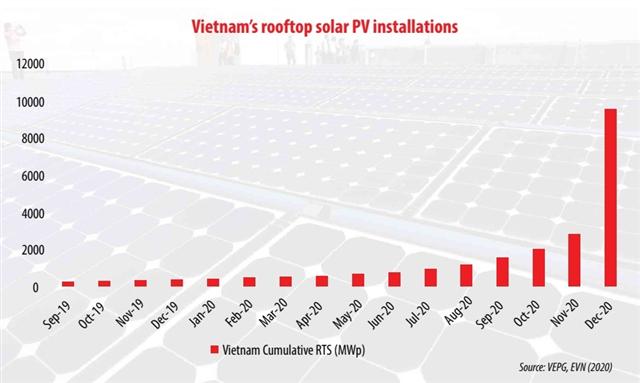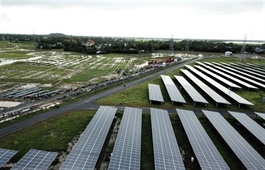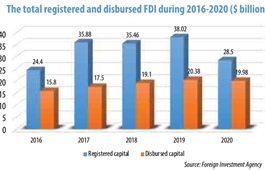Quickfire tactics smash solar rooftop targets
Quickfire tactics smash solar rooftop targets
Rooftop solar installation figures are five years ahead of schedule in Vietnam, thanks to intensive and short-term focus on policy as well as fewer investing barriers in issues such as technical standards.
By the end of 2020 the Vietnamese rooftop solar market had skyrocketed, reaching total installed capacity of 9,300 megawatt-peak. The results mean the government’s 2025 target for rooftop systems has already been smashed.
|
Under Decision No.13/2020/QD-TTg issued last April on encouraging mechanisms for solar power development in Vietnam, it set the deadline of December 31, 2020 for solar systems of any scale to attain a certificate of delivery and enjoy the feed-in tariff 2 (FiT2) rate, in which the respective prices of each kilowatt-hour generated from ground-mounted, floating, and rooftop solar initiatives were 7.09, 7.69, and 8.38 US cents.
As yet there is no new decision or guidance for implementation of the policy after that date. As a result, it remains uncertain which pricing mechanism will apply to grid-connected solar power projects reaching commercial operation date in 2021.
According to a Ministry of Industry and Trade (MoIT) official, the new decision would be released in the first quarter of 2021. Prospects for the extension of the rooftop solar FiT policy have now dimmed, and state-run Electricity of Vietnam (EVN) has noted that new power purchase agreements of rooftop solar power would cease with the expiration of the FiT2 policy.
Meanwhile, EVN has announced its power companies stopped buying rooftop solar power after December 31, 2020, to wait for further guidance from the government. It will also handle requirements for connection and signing power purchase and sales contracts from solar power systems before the deadline.
According to the MoIT, there are currently 16 national standards promulgated by the Ministry of Science and Technology (MoST) related to solar power in general. However, there is a lack of specific standards for the two main components of rooftop solar power projects – panels and inverters.
“As far as I know, the MoST is also planning to continue to publish standards related to the two main devices in the coming time,” said Nguyen Ninh Hai, deputy director of the MoIT’s Electricity and Renewable Energy Authority.
EVN is reviewing solar power purchase contracts as well as strictly handling violations if any are found in the work of testing, installation, and signing of roof power contracts in accordance with the law.
Vietnam is in the process of preparing for a watershed transition from a solar power market using a FiT mechanism to a new competitive auction mechanism
The nationwide solar auction is intended to commence in June, although the relevant studies and draft legal documents for the regime are still in progress. No draft legal documents for a nationwide solar auction have been published yet.
|
Federico Bestiani - Director, BEC Since the update of the policy for FiT2 there has been an unprecedented rush for installations of rooftop systems, and many engineering, procuring, and construction companies had to scale up their operations 10-fold to keep up with the time pressures. After 11 years in the solar industry I have never experienced such a pressure on the whole supply chain including roof sourcing, material supply, installation, testing, and commissioning with EVN. It made a really remarkable endeavour to update its processes and keep up with the huge demand. The next year will be characterised by an even bigger challenge for authorities and developers: to standardise the quality level of rooftop installations in terms of compliance to construction law, electrical standards, and fire safety, and to match the grid availability and local consumption. At the same time, they must find the right supporting mechanism that enables organic development of rooftop solar and minimises loopholes and speculative projects. Nguyen Thi Lien - Project development manager Vietnam, Trina Solar Co., Ltd. A reasonable roadmap for rooftop solar should be issued. It should include a regional division of a third FiT to encourage north and central provinces to install more rooftop systems, and in the south where there is better yield. A long-term FiT should also be applied to avoid cases of force majeure, such as the COVID-19 pandemic and national disasters. There have already been too many difficulties for rooftop solar systems in the past year with investors rushing to catch the FiT deadline, and this must be taken into account. Incentives are required for local households to install rooftop systems through preferential programmes to support those in difficult living conditions. There should also be encouragement for commercial and industrial sectors in which there can be potential for rooftop schemes. Rooftop solar should develop at a reasonable pace and follow government policies meeting equipment standards. Nguyen Dang Anh Thi - Energy, environment and sustainability expert The solar rooftop boom in Vietnam indicates that private financial resources for renewable energy investment across the whole of the country are enormously available. The key thing is how to ensure that reasonable and attractive policies are in place so that the country is able to best use these financial resources. At the same time, the solar rooftop situation here poses and creates a challenge for the grid operator regarding how to optimise this renewable electricity feeding into the grid, while also considering the interests of the electricity producers. As the percentage rate of variable renewable energy is increasing in the country, a more conventional transformation to the smart grid is being seen as urgently needed. Further, some grid flexibility solutions such as energy storage and demand response should be considered in order to facilitate the clean energy transition in Vietnam. Bui Viet Phuong - Solar marketing manager, Dat Solar The solar power boom here in Vietnam has demonstrated many shortcomings. For example, the grid and connection in some local areas are not ready for all registered projects. In addition, some industrial parks which require more rooftop systems have not attracted as much as has been initially expected. Solar rooftop planning should go alongside industrial development planning in Vietnam, because the demand for electricity in the industrial production sector accounts for about 50 per cent of the total output. Therefore, authorised agencies in the country should be required to develop a robust mechanism in order to encourage the strong development of rooftop solar power. Furthermore, top priority should be given to areas and provinces that already boast a number of industrial parks Also necessary is the creation of various incentives for energy storage in order to ensure efficient energy. |
























